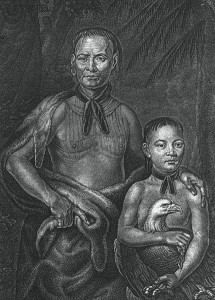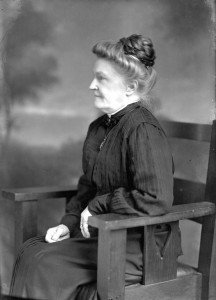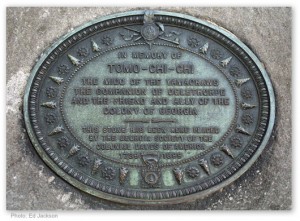On December 16, 2011, the subject of my blog was William Washington Gordon I, Juliette “Daisy” Gordon Low’s grandfather. I mentioned the memorial to him located on Wright Square in Savannah, Georgia, and concluded with a teaser about another story that connects the Gordon memorial with Daisy’s mother, Nellie Kinzie Gordon. I thought I’d briefly tell that amazing tale this week. It is a familiar one to Savannahians, but perhaps not so well-known to others.
Daisy was who she was thanks in large part to her extraordinary mother. Nellie Gordon was a force to be reckoned with. She was intelligent, persuasive, commonsensical, driven, and civic-minded. In 1883, when the Central of Georgia Railroad Company and the Savannah city fathers sought to honor her husband’s father, they decided to erect the monument on Wright Square, despite the fact that Wright Square already featured a memorial—to Tomochichi, the famous Yamacraw leader whose help made the English settlement of Georgia possible.
Tomochichi provided wise mediation between the Native Americans and the English colonists, led by James Oglethorpe. In 1734, Tomochichi traveled with Oglethorpe back to England where he requested official acknowledgement of the Yamacraw and their rights, and the establishment of schools for Yamacraw and Creek children. When he returned, his testimony convinced other tribes to work with Oglethorpe rather than to resist English encroachment. Oglethorpe counted on Tomochichi’s diplomatic powers with other Native peoples as well as with the Spanish settlers in the vicinity. Tomochichi’s commitment to peaceful relations all around helped to further the success of the young Georgia colony. When he died in 1739, English Georgians mourned the passing of a friend. He was laid to rest in Savannah’s Percival Square, under a burial mound of stones.
Percival Square was later renamed Wright Square, and it was directly over the grave of Tomochichi that the Central of Georgia planned to place its memorial to William Washington Gordon I.
Nellie Gordon had a problem with that.
She was, after all, the granddaughter of John Kinzie, a Chicagoan well-known in his time for his friendship with Native Americans. Kinzie and his son, John Harris Kinzie (Nellie’s father) spoke Native American languages, traded with many tribes in the Northwest Territory, worked together in diplomatic and military endeavors. Nellie’s mother, Juliette Magill Kinzie, was the author of Wau-Bun: The “Early Day” in the North-West, which told the story of how she and John Harris Kinzie had settled at Fort Winnebago in Detroit because he was the government’s Indian agent. Nellie had thus grown up with an uncommon but deeply held respect for Native Americans. It was a complicated set of emotions and compulsions behind her desire to maintain a suitable memorial to Tomochichi, but Nellie set out to make it so.
Using her network of friends at the Georgia chapter of the Colonial Dames–which she had just established–Nellie Gordon determined to place a large piece of Georgia granite in Wright Square with a plaque noting Tomochichi’s significance. It would be the organization’s first public service. According to the National Society of the Colonial Dames of America in the State of Georgia:
“Nellie wrote to the Stone Mountain Co. in Atlanta asking them the price of a large boulder of Georgia granite that could serve as a monument. The company replied that they had the perfect thing—a huge granite boulder– and they would be delighted to send it as a gift to such a worthy cause, and, furthermore, since General Gordon had been a president of the railroad, there would be no shipping charges.
Nellie replied politely and thanked the Stone Mountain Co. for their generous offer but explained that the ladies of the Colonial Dames wanted this to be their own contribution to the community so would the company please send a bill. The bill arrived shortly afterwards and was for the sum of one dollar, “payable on the Day of Judgment.” Nellie wrote back and explained that she and “the other ladies would be entirely too busy attending to their own affairs on that momentous day,” so she enclosed a dollar bill to settle the matter.”
Nellie Gordon’s goal became a reality. One hundred and sixty years after Tomochichi’s death, the Colonial Dames memorialized his remarkable life and spirit with the boulder and the plaque that reads:
In memory
of Tomo-chi-chi
the Mico of the Yamacraws
the companion of Oglethrope
and the friend and ally of the
colony of Georgia
this stone has been here placed
by the Georgia Society of the
Colonial Dames of America
1739-1899
_______________________
To read more, see:
- The National Society of the Colonial Dames of America in the State of Georgia website. http://nscdaga.org
- Russell, Preson, and Barbara Hines. Savannah: A History of Her People Since 1733. Savannah: Frederic C. Beil, 1992.
- Sweet, Julie Ann. “Tomochichi (ca. 1644-1739). The New Georgia Encyclopedia Online. http://www.georgiaencyclopedia.org/nge/Article.jsp?id=h-689
- Todd, Helen. Tomochichi: Indian Friend of the Georgia Colony. Atlanta: Cherokee Publishing, 1977.
- “Tomochichi United States Courthouse,” Congressional Record, 11 May 2004, 8990-8991.
- Photo of Nellie Gordon from georgiahistory.com; photo of Tomochichi from wikimedia; photo of memorial from http://georgiainfo.galileo.usg.edu, Mary Stakes, photographer; photo of plaque also from http://georgiainfo.galileo.usg.edu, Ed Jackson, photographer.






I remember that in 2001 I took our troop of 10 girls from California to Savannah. A tour guide had us do a “good luck” chant around the Tomochichi memorial. I believe it’s a common ritual for visiting Girl Scouts to Savannah. Or, perhaps he just had a good laugh watching us! Your story reminded me of that very fun time. Thanks.
Hi, Sue–Thanks so much for your comment and your kind words.
I would love to know whether other Girl Scouts did a similar chant around the Tomochichi memorial–Anyone else?
Yes, at the direction of a GS walking group guide we met there, our GS group walked around the monument chanting “Tomichichi Tomichichi” and then stopped to hear an answer- never got one!
Paula–Thanks for your comments! I think your idea for Alice Gordon’s grave is splendid!
Nellie was a remarkable woman! Isn’t it a shame that Nellie’s gravestone and others of the Gordon family at Laurel Grove are so deteriorated that you cannot even read names? Next time I go to Savannah I am going to take rosemary and rue for Alice’s grave.
The ritual I remember is to walk around tomochichi’s grave 3 times and ask him what he’s been doing all these years. He’ll tell you ‘nothing’.